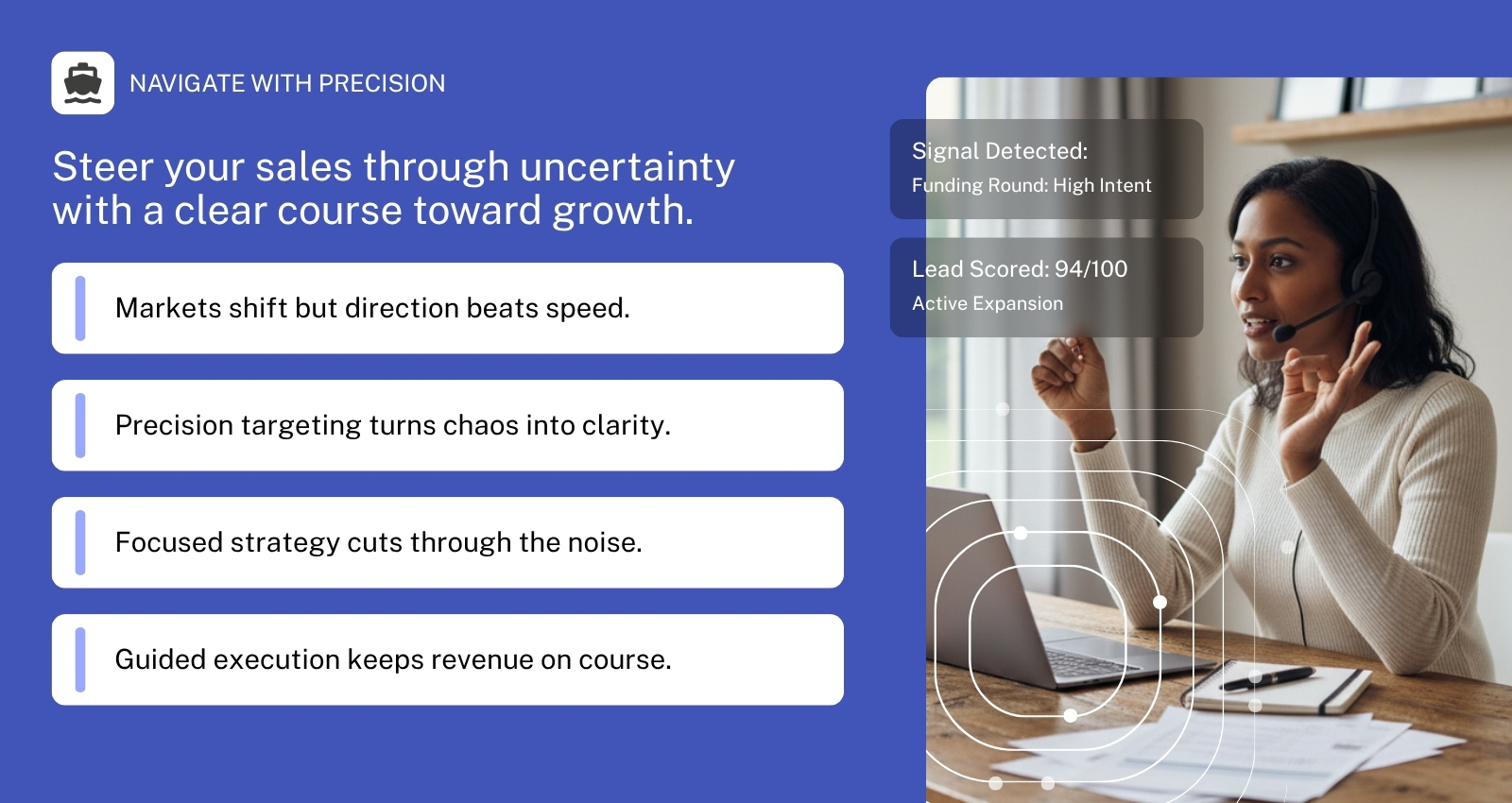

Is a Smaller Account List Always the Right Choice for ABM?
Account-Based Marketing (ABM) was constructed to ‘flip the funnel’. Where traditional marketing methods focused on casting a wide net, ABM sought to switch it up by focusing on quality over quantity. Because of this, it’s often thought that the fewer accounts you target, the better chance of success. Whilst this can sometimes be true, it very much depends on one key point: your objectives with ABM.
Even those with just a base knowledge of ABM will tell you how important the actual accounts you target are to the success of the campaign. After all, it’s in the name.
Yes, account selection is a pivotal, if not the most pivotal part of ABM. However, this tends to be focused on the right accounts to target, based on the best fit to your Ideal Customer Profile (ICP), the lowest hanging fruit, etc. Despite this, what companies don’t often truly consider is how many accounts they should actually target with ABM.
Whilst ABM is primarily used to win new business, it’s being used more and more frequently to hit other KPIs for both marketing and sales. In this blog, we’ll be going over three key ABM objectives and whether it’s still best to narrow down the account list. If you’re wondering what kind of objectives you should be measuring for ABM, you can check out our list of the top 10 ABM metrics here.
If engagement is the key objective…
If generating engagement is your ABM objective, you should immediately be discounting one-to-few and one-to-one ABM. One-to-one ABM should only be used to target existing customers with high potential for upsell or cross-sell opportunities. Similarly, one-to-few ABM should be used on target accounts with high engagement and penetration across multiple key stakeholders.

To ensure maximum engagement from your ABM programme, you need to maximise the number of accounts/contacts you’re targeting. This may sound fairly obvious, but some are fixated on narrowing the account list down to the ones they really want to win, regardless of if the objective is to just get a foot in the door.
Looking for leads?
Similar to engagement, if leads are the end goal, why restrict yourself with a one-to-few approach? Often, the rationale is that by narrowing down the account list, but targeting lots of different personas in each account, the contact list will still be large enough to get the desired results.
Whilst it’s best practice ABM to target multiple stakeholders at each account, the problem is that you’re limiting the amount of eventual pipeline you will get.
Say you’re targeting 20 accounts, but are targeting 10 contacts at each account for 200 contacts in total. Using the 95-5 rule[1], which states that based on a five-year contract length (for example, this principle can still be applied to any contract length), only 20% of accounts are in market in any year, and only 5% in any quarter. Therefore, only four accounts of the 20 will be in market in a year, and just one in any quarter.
Oh, and this is all whilst going up against your competitors.

So yes you may get 10 leads, but if all 10 are at the same company (the only one in market), then the pipeline value is going to be limited. Of course this is all hypothetical, but if it’s leads you’re after, why wouldn’t you go out to as many accounts within your total addressable market (TAM)? If for nothing else, to ensure maximum returns.
Is ROI the end goal?
Ultimately, if you’re targeting a small number of accounts in a one-to-few ABM approach, the most likely KPI is return on investment. This makes sense; these are likely to be large, strategic accounts with lots of potential, and if they’re current customers with good engagement, and you’re looking to cross-sell or upsell, perfect.
However, this is seldom the case. Sometimes they are the biggest named accounts that will spend the most money, other times it’s the best case scenario accounts that sales have struggled to penetrate. Either way, if there aren’t relationships to leverage, it’s going to be very hard to land the account.
With all marketing campaigns but especially with ABM, you need to weigh up what is more important to your organisation: the accounts or the objectives. If you want to be penetrating certain accounts (however you decide upon them), you need to seriously consider what metrics you’re putting against the campaign into them and how you determine success within the account.
If the ultimate goal is the focus of building your campaign, then you need to do everything in your power to tailor the campaign to succeed in that regard. If that objective is ROI, that means picking the accounts that are most likely to succeed and putting the necessary resources into them. This is where picking a one-to-few or one-to-one approach makes complete sense. Just remember that these accounts need to have a level of engagement that makes success more likely, you need to be picking the ‘lowest hanging fruit’.
So, more or less accounts? The answer? It depends, but more often than not, more.
ABM is sometimes seen as a counter to traditional marketing efforts, ‘flipping the funnel’ and less is more… but as we’ve seen, this isn’t always the case. Sometimes it’s worth widening the pool to ensure maximum returns, then once you have the engagement from the initial campaign, you can leverage a more targeted approach.
Just be sure to truly consider what’s more important for the business at the time, the accounts, or the objectives.
[1] https://business.linkedin.com/content/dam/me/business/en-us/marketing-solutions/resources/pdfs/advertising-effectiveness-and-the-95-5-rule.pdf

Account-Based Marketing (ABM) was constructed to ‘flip the funnel’. Where traditional marketing methods focused on casting a wide net, ABM sought to switch it up by focusing on quality over quantity. Because of this, it’s often thought that the fewer accounts you target, the better chance of success. Whilst this can sometimes be true, it very much depends on one key point: your objectives with ABM.
Even those with just a base knowledge of ABM will tell you how important the actual accounts you target are to the success of the campaign. After all, it’s in the name.
Yes, account selection is a pivotal, if not the most pivotal part of ABM. However, this tends to be focused on the right accounts to target, based on the best fit to your Ideal Customer Profile (ICP), the lowest hanging fruit, etc. Despite this, what companies don’t often truly consider is how many accounts they should actually target with ABM.
Whilst ABM is primarily used to win new business, it’s being used more and more frequently to hit other KPIs for both marketing and sales. In this blog, we’ll be going over three key ABM objectives and whether it’s still best to narrow down the account list. If you’re wondering what kind of objectives you should be measuring for ABM, you can check out our list of the top 10 ABM metrics here.
If engagement is the key objective…
If generating engagement is your ABM objective, you should immediately be discounting one-to-few and one-to-one ABM. One-to-one ABM should only be used to target existing customers with high potential for upsell or cross-sell opportunities. Similarly, one-to-few ABM should be used on target accounts with high engagement and penetration across multiple key stakeholders.

To ensure maximum engagement from your ABM programme, you need to maximise the number of accounts/contacts you’re targeting. This may sound fairly obvious, but some are fixated on narrowing the account list down to the ones they really want to win, regardless of if the objective is to just get a foot in the door.
Looking for leads?
Similar to engagement, if leads are the end goal, why restrict yourself with a one-to-few approach? Often, the rationale is that by narrowing down the account list, but targeting lots of different personas in each account, the contact list will still be large enough to get the desired results.
Whilst it’s best practice ABM to target multiple stakeholders at each account, the problem is that you’re limiting the amount of eventual pipeline you will get.
Say you’re targeting 20 accounts, but are targeting 10 contacts at each account for 200 contacts in total. Using the 95-5 rule[1], which states that based on a five-year contract length (for example, this principle can still be applied to any contract length), only 20% of accounts are in market in any year, and only 5% in any quarter. Therefore, only four accounts of the 20 will be in market in a year, and just one in any quarter.
Oh, and this is all whilst going up against your competitors.

So yes you may get 10 leads, but if all 10 are at the same company (the only one in market), then the pipeline value is going to be limited. Of course this is all hypothetical, but if it’s leads you’re after, why wouldn’t you go out to as many accounts within your total addressable market (TAM)? If for nothing else, to ensure maximum returns.
Is ROI the end goal?
Ultimately, if you’re targeting a small number of accounts in a one-to-few ABM approach, the most likely KPI is return on investment. This makes sense; these are likely to be large, strategic accounts with lots of potential, and if they’re current customers with good engagement, and you’re looking to cross-sell or upsell, perfect.
However, this is seldom the case. Sometimes they are the biggest named accounts that will spend the most money, other times it’s the best case scenario accounts that sales have struggled to penetrate. Either way, if there aren’t relationships to leverage, it’s going to be very hard to land the account.
With all marketing campaigns but especially with ABM, you need to weigh up what is more important to your organisation: the accounts or the objectives. If you want to be penetrating certain accounts (however you decide upon them), you need to seriously consider what metrics you’re putting against the campaign into them and how you determine success within the account.
If the ultimate goal is the focus of building your campaign, then you need to do everything in your power to tailor the campaign to succeed in that regard. If that objective is ROI, that means picking the accounts that are most likely to succeed and putting the necessary resources into them. This is where picking a one-to-few or one-to-one approach makes complete sense. Just remember that these accounts need to have a level of engagement that makes success more likely, you need to be picking the ‘lowest hanging fruit’.
So, more or less accounts? The answer? It depends, but more often than not, more.
ABM is sometimes seen as a counter to traditional marketing efforts, ‘flipping the funnel’ and less is more… but as we’ve seen, this isn’t always the case. Sometimes it’s worth widening the pool to ensure maximum returns, then once you have the engagement from the initial campaign, you can leverage a more targeted approach.
Just be sure to truly consider what’s more important for the business at the time, the accounts, or the objectives.
[1] https://business.linkedin.com/content/dam/me/business/en-us/marketing-solutions/resources/pdfs/advertising-effectiveness-and-the-95-5-rule.pdf















